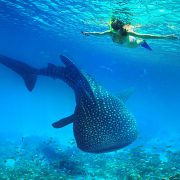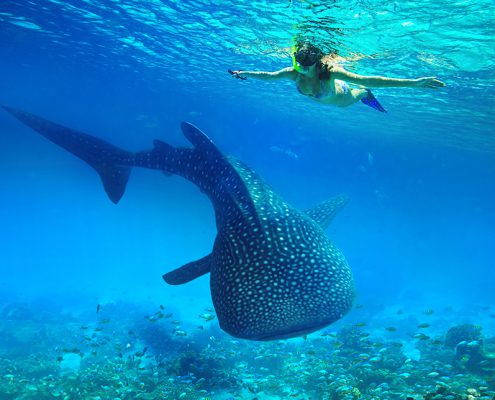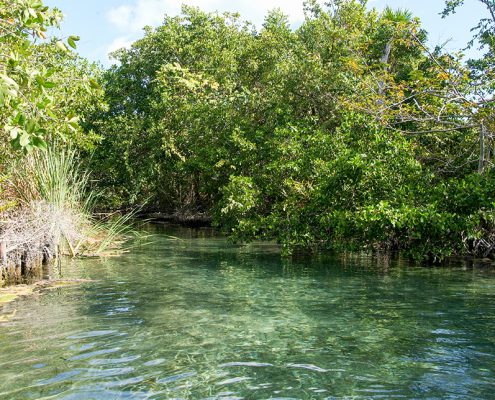If you are traveling to Grand Residences this summer and love the underwater world, plan your own once-in-a-lifetime encounter with nature, an unforgettable swim with the whale sharks. You may have seen these gentle giants in wildlife programs filmed by the BBC and National Geographic but have you ever imagined coming face to face with one? Throughout the summer and up until mid-September, you have the opportunity to swim with the whale sharks in the Mexican Caribbean.
Whale sharks travel thousands of miles in search of food
The world’s largest fish, whale sharks are great ocean travelers, migrating thousands of miles through the tropics in search of the plankton that is their staple diet. They gather in the Mexican Caribbean from mid-May to mid-September, when soaring summer temperatures cause rapid plankton growth and massive blooms of the minute creatures. Biologists have also discovered that it isn’t only plankton that attracts the sharks, but also fish roe. Bonito (little tunny) spawning season is in the summer and whale sharks are partial to the eggs.
Hundreds of whale sharks feast on the nutritious plankton and fish roe broth floating in the waters of the northern Mexican Caribbean. Biologists believe that this is the largest whale shark gathering or aggregation in the world. Up to 400 of them have been counted on one day.
There are actually two whale shark feeding grounds: the area between the island of Holbox and Cabo Catoche, the headland where the Gulf of Mexico meets the Caribbean, and agua azul or “blue water,” the deeper waters to the east of Contoy and Isla Mujeres, a two-and-a-half-hour boat ride from Cancun. Due to the importance of this area for whale sharks and other marine species such as sailfish, marlin, manta rays, dolphins and sea turtles, the Mexican government has declared it a marine biosphere reserve.
Gentle giants
Imagine watching as a creature the size of a bus looms out of the depths, approaches you and then swims placidly by, its gaping jaws open to scoop up the plankton and filter the water out through its gills. You’ll be amazed by the immensity of this gentle giant, its blue grey color and distinctive white spots and the remora fish hitching a ride to keep its skin free of parasites. With a final flick of the tail the whale shark disappears into the distance, leaving you with an incredible sensation of happiness and peace. It is an awe-inspiring sight and an emotional experience, one that wildlife watchers shouldn’t miss.
Domino fish
Whale sharks are also known as “domino fish” due to their stripes and dappled markings. Each fish has its own unique pattern and taking photos of them is helping whale shark experts around the world to compile a catalog. Through the use of this international database for identification purposes and by tagging sharks they can now begin to map the movements of these enigmatic creatures during the year. For example, they have been able to track whale sharks during the year as they swim through the Gulf of Mexico, the Mexican Caribbean, Belize and the Bay Islands. One female whale shark was tracked as far as Brazil.
In the Indo-Pacific region, whale sharks are spotted off the Mozambique coast, the Maldives, Seychelles, Indonesia, Philippines, Australia, Fiji and the Sea of Cortez off Baja California Sur in Mexico.
Eco trips to see the whale sharks
Guided eco trips to see the whale sharks are available from Cancun, Isla Mujeres and Holbox. With a small group of fellow nature lovers, you’ll board a boat bound for the whale shark feeding grounds. Suddenly fins are spotted in the distance and the huge blue grey fish glide past you, one after the other.
The first sighting of a whale shark leaves you speechless, with a lump in your throat and tears in your eyes at the majesty of the creature. As the next one approaches, your guide will tell two people in your group to prepare to jump into the water with him/her and swim alongside it, always keeping a distance. Everyone takes their turn to swim with these beautiful creatures, always following the whale shark season rules:
- Keep a distance of at least five meters from the whale sharks
- Do not attempt to touch whale sharks
- Swim alongside whale sharks, never in front of them or near their tails
- Only two people per boat plus a guide are allowed in the water at one time
- The use of sun products and flash photography are prohibited
On the journey out to the whale shark area, keep a look out for dolphins and sea turtles. Giant manta rays also gather in the whale shark feeding grounds to eat plankton and sometimes leap out of the water in spectacular flight.
Welcome to Holbox, whale shark island
Another way to enjoy this amazing eco adventure is to plan an overnight trip to Holbox, the beautiful island on the north coast of Quintana Roo.
This is whale shark country and even the wooden signs and colorful murals lining the sandy streets show the famous pez domino as local fishermen affectionately call the whale shark. Go in search of whale sharks early in the morning and then feast on locally caught lobster and fish at one of the village restaurants. In the afternoon, take another boat trip to explore the Yalahau Lagoon, Isla de los Pajaros (Bird Island) and the Yalahau Cenote and you’ll still have time for sunset on the beach and to discover the laidback ambiance of the island.
Ask your Concierge
Swimming with whale sharks is an unforgettable experience and if you are interested in the natural world, you won’t want to miss it. Ask your Concierge for information on whale shark trips.








Leave a Reply
Want to join the discussion?Feel free to contribute!